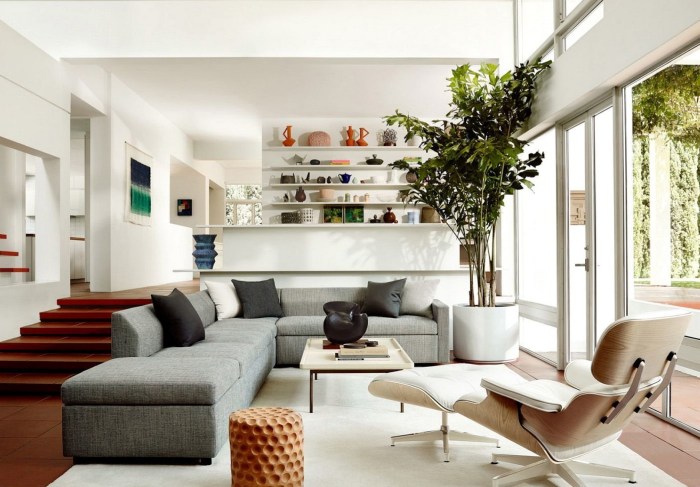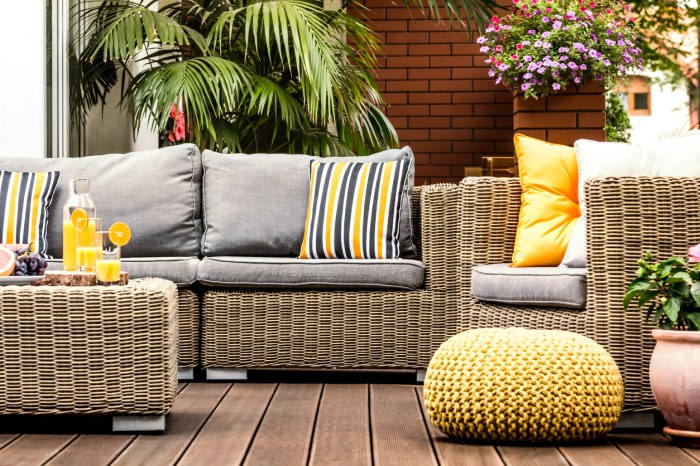
Kicking off with Modern Living and Sustainable Materials, this opening paragraph is designed to captivate and engage the readers, presenting a glimpse into the world of modern living spaces and sustainable materials. From innovative architectural designs to eco-friendly interior elements, this topic explores the perfect blend of style and sustainability in contemporary living.
Modern Living

In the context of architecture and interior design, modern living refers to a design style that emphasizes simplicity, functionality, and minimalism. Modern living spaces are characterized by clean lines, open floor plans, and a focus on natural light and materials.
Differences from Traditional Spaces
- Modern living spaces often have an open floor plan, creating a sense of spaciousness and flow, while traditional spaces are more compartmentalized with separate rooms.
- Modern design features sleek and minimalist furniture, with a focus on geometric shapes and neutral colors, whereas traditional spaces may have more ornate and decorative elements.
- Technology integration is a key aspect of modern living, with smart home systems, energy-efficient appliances, and sustainable materials being common features, unlike traditional spaces that may lack these technological advancements.
Influence of Technology
Technology plays a significant role in shaping modern living environments. Smart home systems allow for increased convenience and efficiency, with features such as automated lighting, temperature control, and security systems. Energy-efficient appliances help reduce energy consumption and promote sustainability, while advancements in materials science have led to the use of innovative and eco-friendly materials in modern architecture and design.
Sustainable Materials

Sustainable materials are resources that are responsibly sourced, eco-friendly, and have a minimal impact on the environment. In contemporary design, the use of sustainable materials has become increasingly important due to the growing awareness of environmental issues and the need for more eco-conscious practices in architecture and interior design.
Types of Sustainable Materials
- Bamboo: Known for its rapid growth and renewability, bamboo is a popular choice for flooring, furniture, and decor items.
- Recycled Glass: Glass that has been recycled and repurposed into countertops, tiles, and other architectural elements.
- Reclaimed Wood: Salvaged wood from old buildings or furniture that is given new life in modern designs.
- Cork: Harvested from the bark of cork oak trees, cork is a sustainable material used for flooring, wall coverings, and insulation.
Benefits of Sustainable Materials
- Reduced Environmental Impact: Using sustainable materials helps to conserve natural resources and reduce carbon footprint.
- Healthier Living Spaces: Sustainable materials are often free from harmful chemicals and toxins, creating a healthier indoor environment.
- Longevity and Durability: Many sustainable materials are known for their durability and longevity, making them a cost-effective choice in the long run.
- Aesthetic Appeal: Sustainable materials can add a unique and stylish touch to contemporary design, enhancing the overall aesthetic of living spaces.
Minimalist Design
Minimalist design is a design approach that emphasizes simplicity, clean lines, and a clutter-free environment. It focuses on the essentials and eliminates any unnecessary elements, resulting in spaces that are sleek, functional, and visually appealing.
Principles of Minimalist Design
- Avoid clutter: Minimalist design prioritizes open spaces and eliminates unnecessary decorations or furnishings.
- Neutral color palette: The color scheme is often limited to neutral tones like white, beige, or gray to create a sense of calm and simplicity.
- Clean lines: Straight lines and simple shapes are prominent in minimalist design, contributing to a sense of order and harmony.
- Functional furniture: Furniture pieces are selected for their practicality and functionality, with a focus on quality over quantity.
Comparison with Other Design Styles
Minimalist design contrasts with other styles like traditional or eclectic design in terms of aesthetics and functionality. While traditional design may feature ornate details and rich colors, minimalist design opts for simplicity and a more subdued color palette. In terms of functionality, minimalist design prioritizes practicality and efficiency, whereas eclectic design embraces mix-and-match elements for a more personalized look.
Examples of Minimalist Design Elements
- Open floor plans with minimal partitions to create a sense of spaciousness.
- Sleek and simple furniture pieces with clean lines and no ornate details.
- Lack of excessive decorations or knick-knacks, focusing on a few key pieces for visual interest.
- Use of natural materials like wood, stone, and metal to add warmth and texture to the space.
Modern Classics
Modern classics in design and architecture refer to timeless pieces that have stood the test of time and continue to be relevant and influential in the modern world. These pieces exhibit a perfect balance of form, function, and aesthetics, making them iconic and highly sought after in contemporary design.
Iconic Pieces of Furniture and Architectural Works
- The Barcelona Chair by Ludwig Mies van der Rohe: This iconic chair, originally designed for the German Pavilion at the 1929 International Exposition in Barcelona, is a symbol of modern design with its sleek lines and luxurious materials.
- The Eames Lounge Chair and Ottoman by Charles and Ray Eames: This classic piece is known for its combination of comfort and style, showcasing the duo’s mastery of form and function.
- The Fallingwater House by Frank Lloyd Wright: Considered a masterpiece of organic architecture, this iconic residence seamlessly integrates with its natural surroundings, blurring the lines between indoor and outdoor spaces.
Timeless Appeal of Modern Classics
Modern classics have an enduring popularity due to their ability to transcend trends and remain relevant in ever-changing design landscapes. These pieces exude a sense of sophistication, elegance, and innovation that continues to captivate designers and homeowners alike.
In conclusion, Modern Living and Sustainable Materials offer a promising vision for the future of design and architecture. By embracing sustainable practices and minimalist aesthetics, we can create spaces that not only look visually appealing but also contribute to a greener, more environmentally conscious world.
FAQ Insights
What are the key differences between modern living spaces and traditional ones?
Modern living spaces typically focus on open floor plans, minimalistic designs, and integration of technology, whereas traditional spaces lean towards more ornate decorations and defined room separations.
How can sustainable materials benefit living spaces?
Sustainable materials contribute to a healthier indoor environment, reduce energy consumption, and support ecological balance by minimizing the carbon footprint of construction and design.
What iconic pieces of furniture are considered modern classics?
Items like the Eames Lounge Chair, Barcelona Chair, and Tulip Table are often regarded as modern classics due to their timeless design and enduring popularity.





